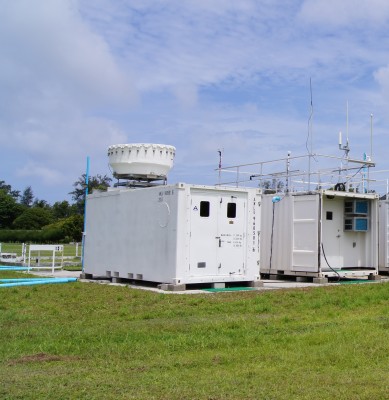Raindrops and the Doppler Effect
Published: 20 August 2012
Editor’s note: As part of the preparations for the upcoming Marine ARM GPCI Investigations of Clouds (MAGIC) field campaign, principal investigator Ernie Lewis discusses how radars use the Doppler effect to determine raindrop sizes and speeds.

Radio waves consist of oscillations that occur a given number of times every second, which by definition is the frequency of the wave. Each of these oscillations propagates at the speed of light toward the receiver, where they will be detected at a later time that is determined by the distance to the object and the speed of light. Because all oscillations travel the same distance and at the same speed from the object to the receiver, the receiver detects the same number of oscillations every second as are being created by the object. In other words, it detects the wave at the same frequency at which it was emitted.
For the situation in which the object is moving toward the radar receiver, the same number of oscillations is being created every second, but each successive oscillation occurs closer to the receiver, and takes less time to travel to the receiver than the previous one. As the motion of the object toward the radar results in more oscillations being received by the radar every second, the frequency is higher. If the object is moving away from the radar the oscillations will be received less often, and the frequency will be lower.
How big are raindrops?

How fast do water drops fall?
For drops near the surface of the Earth, the following approximate values will give an idea of the speeds involved.
- The terminal velocity of a cloud drop, with typical diameter 20 millionths of a meter (approximately one thousandth of an inch), is one centimeter (~1/2 inch) per second.
- For drops comprising drizzle, which are perhaps ten times as large, it is 3/4 of a meter (2 feet) per second.
- Small raindrops, with diameters of one millimeter, fall at 4 meters (13 feet) per second, and large raindrops, with diameters 5 millimeters, fall at 9 meters (30 feet) per second (20 mph).
Another way to look at this is to consider the times required to fall (in still air) a distance of ten meters, the height of a three-story building. Approximate values are fifteen minutes for cloud drops, fifteen seconds for drizzle drops, two second for small raindrops, and one second for large raindrops.
Not only do we know the relation between raindrop size and terminal velocity, we also know how strongly raindrops of a given size reflect radio waves back to the radar. This information means that from the strength of the Doppler signal at a given frequency shift we can determine how many raindrops of the corresponding size are in the volume of air sampled by the radar.
The sizes of the raindrops, plus the number of drops of each size, comprise an important quantity in meteorology known as the drop size distribution (DSD). If the DSD is known, we can calculate the rainfall rate, as we know how much water is in each size of raindrop, how many raindrops of each size there are, and how fast drops of each size are falling.
–Ernie Lewis, MAGIC principal investigator
The ARM Climate Research Facility is a DOE Office of Science user facility. The ARM Facility is operated by nine DOE national laboratories, including .
Keep up with the Atmospheric Observer
Updates on ARM news, events, and opportunities delivered to your inbox
ARM User Profile
ARM welcomes users from all institutions and nations. A free ARM user account is needed to access ARM data.


















